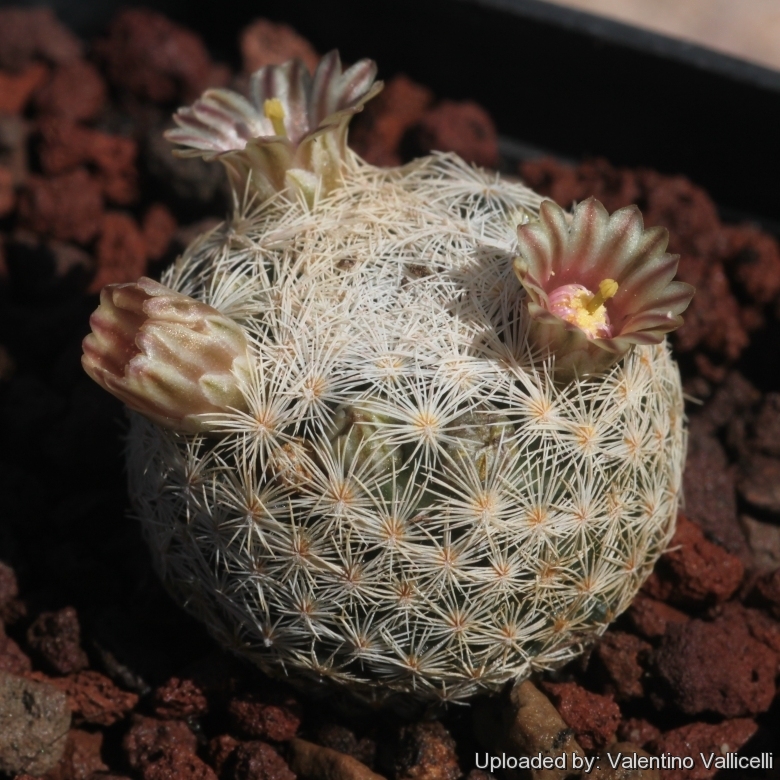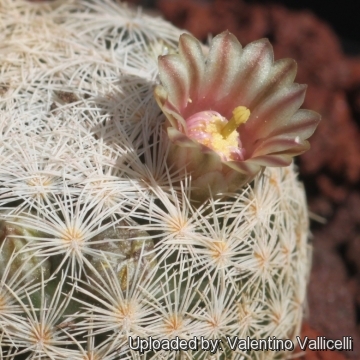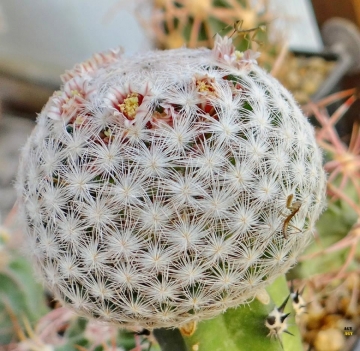Accepted Scientific Name: Mammillaria lasiacantha Engelm.
Proc. Amer. Acad. Arts 3: 261. 1856 Syn. Cact. 5

Mammillaria lasiacantha var. denudata Photo by: Valentino Vallicelli
Origin and Habitat: Big Bend National Park (Brewster County), Texas, USA.
Synonyms:
See all synonyms of Mammillaria lasiacantha
Common Names include:
ENGLISH: Golf Ball Cactus, Lace-spine Cactus, Golf-ball Pincushion, Lace-spine Nipple Cactus
Description: Mammillaria lasiacanthaSN|9075]]SN|9075]] is another very variable species usually unbranched or slowly clustering, deep-seated in substrate and inconspicuous. The variety "denudata" distinguishes from the common Mammillaria lasiacanthaSN|9075]]SN|9075]] for its always glabrous spines. For all other characteristics it is comparable to the standard from. In other populations of Mammillaria lasiacanthaSN|9075]]SN|9075]] the plants may retain plumose spines at maturity.
Stems: Depressed-spheric to short cylindric, 1-3,5 cm wide × 1,5-7 cm tall. Axils bare.
Roots: Diffuse not enlarged.
Spines: 40-80 per areole, in several series but all equally thin, mostly appressed, white or very pale pink, often minutely tipped pinkish brown, innocuous, bristlelike, 0,5-6 mm, glabrous to plumose, all interpreted as radial, innermost spines shortest; No central spines.
Flowers: 1-2,5 cm; white or cream, usually with sharply defined midstripes of green, yellow, tan, pink, pale purple, or reddish, blooming from January to March.
Fruits: Scarlet, cylindric or clavate, 10-25 mm long with floral remnant persistent ripening in June August.
Subspecies, varieties, forms and cultivars of plants belonging to the Mammillaria lasiacantha group
 Mammillaria lasiacantha Engelm.: Single or forming Small clusters of 2 or 3 heads. Stems are spherical usually less than 5 cm in diameter. They usually have soft glabrous spines, but in some populations all plants may retain plumose spines at maturity.
Mammillaria lasiacantha Engelm.: Single or forming Small clusters of 2 or 3 heads. Stems are spherical usually less than 5 cm in diameter. They usually have soft glabrous spines, but in some populations all plants may retain plumose spines at maturity. Mammillaria lasiacantha var. denudata Engelm.: has always glabrous spines. For all other characteristics it is comparable to the standard Mammillaria lasiacantha. Distribution: Big Bend National Park (Brewster County), Texas.
Mammillaria lasiacantha var. denudata Engelm.: has always glabrous spines. For all other characteristics it is comparable to the standard Mammillaria lasiacantha. Distribution: Big Bend National Park (Brewster County), Texas. Mammillaria lasiacantha subs. egregia (Backeb. ex Rogoz. & Appenz.) D.R.Hunt: It forms small snow-white ball, usually unbranched, deep-seated in substrate and inconspicuous that become somewhat cylindrical with age up to 5 cm in diameter × 2-7 cm tall.
Mammillaria lasiacantha subs. egregia (Backeb. ex Rogoz. & Appenz.) D.R.Hunt: It forms small snow-white ball, usually unbranched, deep-seated in substrate and inconspicuous that become somewhat cylindrical with age up to 5 cm in diameter × 2-7 cm tall. Mammillaria lasiacantha subs. egregia f. cristata hort.: crested form. It will slowly forms white tangled groups up to 10 cm in diameter.
Mammillaria lasiacantha subs. egregia f. cristata hort.: crested form. It will slowly forms white tangled groups up to 10 cm in diameter.- Mammillaria lasiacantha subs. hyalina D.R.Hunt
 Mammillaria lasiacantha subs. magallanii (F.Schmoll ex R.T.Craig) D.R.Hunt: Small usually solitary slow growing species with short white spines. Stems globose to club shaped, green, up to 6 cm tall and 4.5 cm in diameter. Distribution: Coahuila and Durango.
Mammillaria lasiacantha subs. magallanii (F.Schmoll ex R.T.Craig) D.R.Hunt: Small usually solitary slow growing species with short white spines. Stems globose to club shaped, green, up to 6 cm tall and 4.5 cm in diameter. Distribution: Coahuila and Durango. Mammillaria lasiacantha f. wohlschlageri (Repp.) Hoeve: Small plants with a flat fuzzy stem and creamy flowers blooming abundantly in late winter-to early spring. Radial spiness 26-36, glassy white, brown tipped, 2 - 6 mm long.
Mammillaria lasiacantha f. wohlschlageri (Repp.) Hoeve: Small plants with a flat fuzzy stem and creamy flowers blooming abundantly in late winter-to early spring. Radial spiness 26-36, glassy white, brown tipped, 2 - 6 mm long. Mammillaria magallani var. hamatispina Backeb.: 50-70 creamy-yellowish radial spines with one hooked darker central spine.
Mammillaria magallani var. hamatispina Backeb.: 50-70 creamy-yellowish radial spines with one hooked darker central spine. Mammillaria neobertrandiana Backeb.: Nice pink spines, the small winter flowers are pale pink with a pink/brown midstripe. Distribution: Lerdo, Durango.
Mammillaria neobertrandiana Backeb.: Nice pink spines, the small winter flowers are pale pink with a pink/brown midstripe. Distribution: Lerdo, Durango. Mammillaria roemeri Wolfg.Krüger & W.Rischer: It is a neotonic (juvenile form which remains so) form of Mammillaria lasiacantha. The flower position and its later flowering distinguish it, as well as the spination. It looks different, but clearly related.
Mammillaria roemeri Wolfg.Krüger & W.Rischer: It is a neotonic (juvenile form which remains so) form of Mammillaria lasiacantha. The flower position and its later flowering distinguish it, as well as the spination. It looks different, but clearly related. Mammillaria roseocentra Boed. & F.Ritter: radial spines numerous, in two rows, short, especially the inside one, initially beautiful pink, at the apex almost red: Distribution: Durango and Lerdo, Mexico
Mammillaria roseocentra Boed. & F.Ritter: radial spines numerous, in two rows, short, especially the inside one, initially beautiful pink, at the apex almost red: Distribution: Durango and Lerdo, Mexico Mammillaria sp. f. cristata SB500 Cuatrocienagas, Coahuila, Mexico: is a tiny crest form that may retain plumose spines at maturity.It slowly forms tangled groups up to 20 cm in diameter.
Mammillaria sp. f. cristata SB500 Cuatrocienagas, Coahuila, Mexico: is a tiny crest form that may retain plumose spines at maturity.It slowly forms tangled groups up to 20 cm in diameter. Mammillaria sp. SB500 Cuatrocienagas, Coahuila, Mexico hort., S.Brack: (M. lasiacantha) Feathery form with tiny stems that resemble golf balls.
Mammillaria sp. SB500 Cuatrocienagas, Coahuila, Mexico hort., S.Brack: (M. lasiacantha) Feathery form with tiny stems that resemble golf balls.
Bibliography: Major references and further lectures
1) David Hunt, Nigel Taylor “The New Cactus Lexicon” DH Books, 2006 ISBN 0953813444, 9780953813445
2) John Pilbeam (1999) “Mammillaria The Cactus File Handbook” Nuffield Press. ISBN 10: 0952830280
Nathaniel Lord Britton, Joseph Nelson Rose “Cactaceae: Descriptions and Illustrations of Plants of the Cactus Family” Courier Dover Publications, 1963
3) Edward F. Anderson “The Cactus Family” Timber Press, 2001
4) James Cullen, Sabina G. Knees, H. Suzanne Cubey “The European Garden Flora Flowering Plants: A Manual for the Identification of Plants Cultivated in Europe, Both Out-of-Doors and Under Glass”Cambridge University Press, 11/ago/2011
 Mammillaria lasiacantha var. denudata Photo by: Valentino Vallicelli
Mammillaria lasiacantha var. denudata Photo by: Valentino Vallicelli Together with 2 young Mantis religiosa. Photo by: Agócs György
Together with 2 young Mantis religiosa. Photo by: Agócs GyörgyCultivation and Propagation: This plant has not the fame to be easy to cultivate, but in good conditions with very careful application of water and excellent ventilation, it grows without difficulty. Be careful to encourage slow growth, but if you succeed in growing a colony of stems, then the results will repay all the growing efforts.
Growing rate: It is a slow growing species that will make clumps given the best conditions, but rewards the patient grower with a beautiful displays of flowers since from an early age.
Soil: Requires excellent drainage provided by a very permeable open cactus soil (With not less than 50% grit content). Avoid the use of peat or other humus sources in the potting mixture.
Repotting: Repot every 2-3 years. Use small sized pots.
Feeding: During the beautiful season enrich the soil using a fertilizer rich in potassium and phosphorous, but poor in nitrogen, because this chemical element doesn’t help the development of succulent plants, making them too soft and full of water.
Watering: Water should be carefully applied and only when the soil is dry to the touch, as this cliff-dwelling species is very prone to root rot. Allow soil to drain thoroughly before watering again. Additionally, water should not be applied from above, as the feathery spines will retain water and add to rotting problems, but in good conditions with excellent ventilation, in bright light, it usually grows without particular difficulty. Do not water in the winter.
Light: Outside full sun or afternoon shade, inside it needs bright light, and some direct sun. Direct sun encourages flowering and heavy spine production.
Hardiness: Protect from frost. But it's hardy to -5°C if kept dry. A winter rest that allows the plant to shrivel (perhaps losing up to 25% of its summer height) will encourage flowering and long time survival.
Pests & diseases: It may be attractive to a variety of insects, but plants in good condition should be nearly pest-free, particularly if they are grown in a mineral potting-mix, with good exposure and ventilation. Nonetheless, there are several pests to watch for:
- Red spiders: Red spiders may be effectively rubbed up by misting the vulnerable plants every day
- Mealy bugs: occasionally they develop aerial into the new growth among the wool with disfiguring results, but the worst types develop underground on the roots and are invisible except by their effects.
- Scales: Scales are rarely a problem.
- Rot: it is only a minor problem with cacti if the plants are watered and “aired” correctly. If they are not, fungicides won't help all that much.
Propagation: Direct sow after last frost or (rarely) cuttings. Seeds germinate in 7-14 days at 21-27° C in spring, remove gradually the glass cover as soon the plants will be well rooted (ca 1-2 weeks) and keep ventilated, no full sun for young plants!












